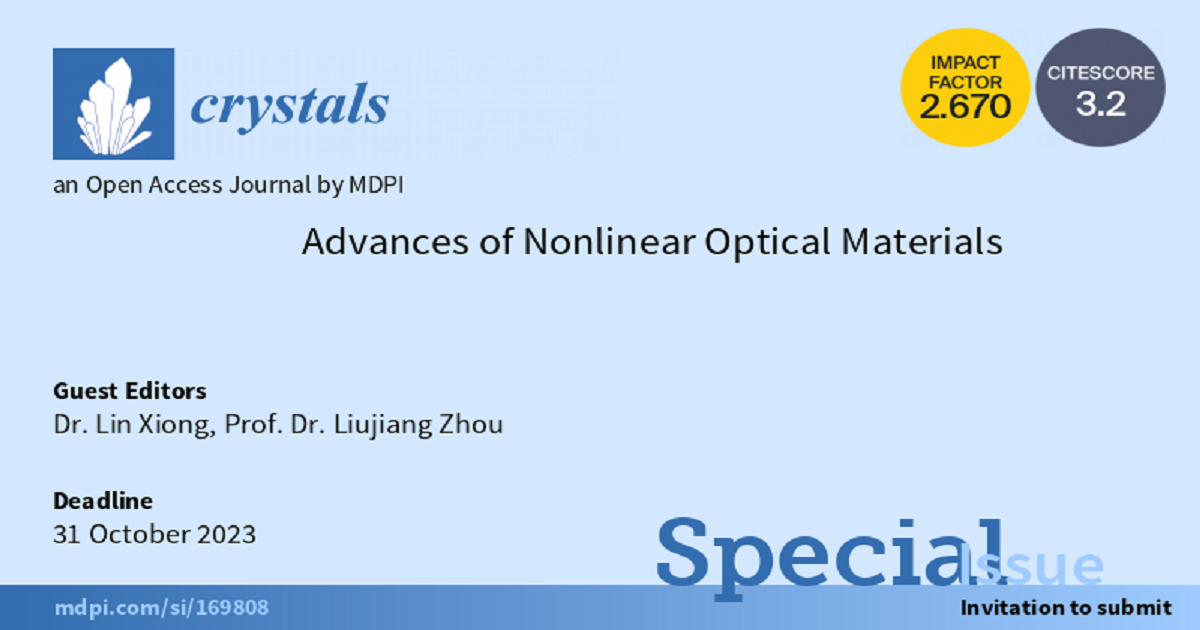- 2.4Impact Factor
- 5.0CiteScore
- 13 daysTime to First Decision
Advances of Nonlinear Optical Materials
This special issue belongs to the section “Inorganic Crystalline Materials“.
Special Issue Information
Dear Colleagues,
Nonlinear optical (NLO) materials, as the heart of frequency conversion systems, are used to convert coherent light to other desirable wavelengths, ranging from deep-ultraviolet (DUV) to infrared (IR). The conversion occurs via a number of processes, such as second-harmonic generation (SHG) and difference-frequency generation. NLO materials have played an increasing role in a variety of areas, such as information storage, medical devices, laser systems, detectors, and photolithography. Ideally, SHG materials should satisfy several fundamental requirements, including proper phase matching, high NLO coefficients, stability in various chemical environments, a high laser-induced damage threshold (LIDT), relevant transparent windows in applied wavelengths, and the ability to be grown as large, crack-free single crystals. Therefore, exploring new NLO fundamental modules, achieving a good performance balance, and identifying novel NLO crystal candidates are topics of interest in the field of NLO materials.
In this Special Issue, we will collect and review the latest developments in experimental and theoretical studies of new NLO materials, focusing on their synthesis methods, design strategies, theoretical mechanisms, linear and nonlinear optical properties, etc. We believe that this Special Issue will shed light on the further exploration and design of high-performance NLO materials.
Dr. Lin Xiong
Prof. Dr. Liujiang Zhou
Guest Editors
Manuscript Submission Information
Manuscripts should be submitted online at www.mdpi.com by registering and logging in to this website. Once you are registered, click here to go to the submission form. Manuscripts can be submitted until the deadline. All submissions that pass pre-check are peer-reviewed. Accepted papers will be published continuously in the journal (as soon as accepted) and will be listed together on the special issue website. Research articles, review articles as well as short communications are invited. For planned papers, a title and short abstract (about 250 words) can be sent to the Editorial Office for assessment.
Submitted manuscripts should not have been published previously, nor be under consideration for publication elsewhere (except conference proceedings papers). All manuscripts are thoroughly refereed through a single-blind peer-review process. A guide for authors and other relevant information for submission of manuscripts is available on the Instructions for Authors page. Crystals is an international peer-reviewed open access monthly journal published by MDPI.
Please visit the Instructions for Authors page before submitting a manuscript. The Article Processing Charge (APC) for publication in this open access journal is 2100 CHF (Swiss Francs). Submitted papers should be well formatted and use good English. Authors may use MDPI's English editing service prior to publication or during author revisions.
Keywords
- nonlinear optical material
- birefringence
- second harmonic generation
- noncentrosymmetric
- first-principles calculation
- hydrothermal synthesis

Benefits of Publishing in a Special Issue
- Ease of navigation: Grouping papers by topic helps scholars navigate broad scope journals more efficiently.
- Greater discoverability: Special Issues support the reach and impact of scientific research. Articles in Special Issues are more discoverable and cited more frequently.
- Expansion of research network: Special Issues facilitate connections among authors, fostering scientific collaborations.
- External promotion: Articles in Special Issues are often promoted through the journal's social media, increasing their visibility.
- e-Book format: Special Issues with more than 10 articles can be published as dedicated e-books, ensuring wide and rapid dissemination.

